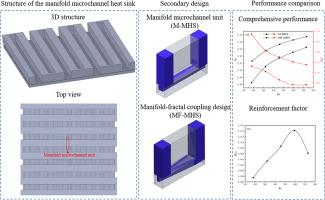Secondary heat transfer enhancement design of manifold microchannels based on entransy theory
IF 3.9
3区 工程技术
Q3 ENERGY & FUELS
Chemical Engineering and Processing - Process Intensification
Pub Date : 2025-10-01
DOI:10.1016/j.cep.2025.110574
引用次数: 0
Abstract
Manifold microchannel heat sinks (M-MHSs) are preferred solutions for ultrahigh heat flux heat dissipation in electronic chips. To further enhance heat transfer, the heat transfer mechanism of M-MHS was studied based on entransy theory, and a manifold and fractal coupling microchannel heat sink (MF-MHS) was proposed. The results revealed that the M-MHS can enhance heat transfer, which is attributed mainly to the impact effect and chaos flow caused by the transition of fluid from the manifold to the microchannel, leading to a greater entransy gain and lower entransy dissipation in the channel centre and near the channel wall. The proposed MF-MHS can further improve the entransy gain and decrease the entransy dissipation, thus enhancing heat transfer. Under the same Reynolds number, the comprehensive performance of the MF-MHS increased the convective heat transfer efficiency by 1.6 %-3.3 %. Finally, a reinforcement factor was proposed to evaluate the coupling effect on heat and mass transfer. The results revealed that although the MF-MHS can enhance convective heat transfer, the manifold-microchannel coupling effect will suppress the convective heat transfer performance. This work might provide guidance for the heat transfer mechanism analysis and active design for MHSs.

基于熵理论的多管微通道二次强化传热设计
流形微通道散热器(m - mhs)是电子芯片超高热流密度散热的首选解决方案。为了进一步强化传热,基于熵理论研究了M-MHS的传热机理,提出了一种流形与分形耦合的微通道散热器(MF-MHS)。结果表明,M-MHS能够增强换热,其主要原因是流体从流形向微通道过渡所引起的冲击效应和混沌流动,导致通道中心和通道壁面附近的能量增益增大,能量耗散减小。所提出的MF-MHS可以进一步提高能量增益,降低能量耗散,从而增强传热。在相同雷诺数下,MF-MHS的综合性能使对流换热效率提高了1.6% ~ 3.3%。最后,提出了一个强化系数来评价传热传质耦合效应。结果表明,虽然MF-MHS可以增强对流换热,但歧管-微通道耦合效应会抑制对流换热性能。研究结果可为mhs的传热机理分析和主动设计提供指导。
本文章由计算机程序翻译,如有差异,请以英文原文为准。
求助全文
约1分钟内获得全文
求助全文
来源期刊
CiteScore
7.80
自引率
9.30%
发文量
408
审稿时长
49 days
期刊介绍:
Chemical Engineering and Processing: Process Intensification is intended for practicing researchers in industry and academia, working in the field of Process Engineering and related to the subject of Process Intensification.Articles published in the Journal demonstrate how novel discoveries, developments and theories in the field of Process Engineering and in particular Process Intensification may be used for analysis and design of innovative equipment and processing methods with substantially improved sustainability, efficiency and environmental performance.

 求助内容:
求助内容: 应助结果提醒方式:
应助结果提醒方式:


